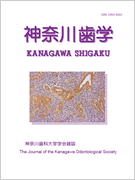- HOME
- > 一般の方
- > バックナンバー:神奈川歯学
- > 24巻1号
- > アブストラクト
アブストラクト(24巻1号:神奈川歯学)

Japanese
| Title : | 咬筋小胞体のSteady-State Calcium蓄積とCaffeineによる抑制 |
|---|---|
| Subtitle : | 原著 |
| Authors : | 齋藤元, 伊藤春生 |
| Authors(kana) : | |
| Organization : | 神奈川歯科大学歯科薬理学教室 |
| Journal : | 神奈川歯学 |
| Volume : | 24 |
| Number : | 1 |
| Page : | 169-181 |
| Year/Month : | 1989 / 6 |
| Article : | 原著 |
| Publisher : | 神奈川歯科大学学会 |
| Abstract : | 「緒言」骨格筋の生理的収縮は, 細胞質中のCa2+濃度の増加に伴って引き起こされるものであり, この筋収縮を引き起こすCa2+は, 静止時には筋小胞体(SR)に貯蔵されている. 細胞内膜系であるSRの機能は, 細胞膜を介したCa2+の流入や細胞興奮に連動して自身の内胞に貯蔵しているCa2+を放出することで細胞質内Ca2+を上昇(10-5M)させ, 筋原線維の活性化(収縮)をもたらすことと, 増加した細胞内Ca2+をATP依存性Ca2+ポンプで内腔へ汲み上げ, 細胞内Ca2+を減少(10-7M)させる結果, 筋原線維の弛緩をもたらすことである. SRによるCa2+の汲み上げに関しては, その大部分がATP依存性Ca2+ポンプ機構で説明可能であるが, Ca2+放出の経路については一定の見解がない. 現時点で考えられる一連の興奮-収縮連関過程に関与するSRからのCa2+放出経路は, 1) Ca2+によるCa2+放出(Ca2+-induced Ca2+ releaseチャンネルを経由するCa2+放出), 2) Ca2+ポンプの逆回転によるCa2+の放出, 3) 受動的Ca2+拡散(passive Ca2+permeability), そして4) Ca2+-induced Ca2+ releaseチャンネル以外のCa2+チャンネルを介するCa2+放出, などである. |
| Practice : | 歯科学 |
| Keywords : | 咬筋小胞体, steady-state Ca2+蓄積, caffeine, Ca2+ permeability, Ca2+チャンネル |
English
| Title : | Steady-State Calcium Accumulation and Its Reduction by Caffeine in Sarcoplasmic Reticulum from Masseter Muscle |
|---|---|
| Subtitle : | Original article |
| Authors : | Gen SAITO, Haruo Ito |
| Authors(kana) : | |
| Organization : | Department of Pharmacology, Kanagawa Dental College |
| Journal : | Kanagawa Shigaku |
| Volume : | 24 |
| Number : | 1 |
| Page : | 169-181 |
| Year/Month : | 1989 / 6 |
| Article : | Original article |
| Publisher : | Kanagawa Odontological Society |
| Abstract : | Abstract : The passive Ca2+ efflux pathways in skeletal sarcoplasmic reticulum (SR) vesicles include the efflux through a Ca2+ channel and a passive leak parallel to the channel and the pump. It is known that caffeine stimulates Ca2+-induced Ca2+ release. To gain further insight into the effect of caffeine on Ca2+ flux behavior of canine masseter muscle SR vesicles, the present study focuses on the interaction of steady-state Ca2+ accumulation and passive Ca2+ permeability in the presence or absence of endogenous calmodulin (CaM), which is known to regulate Ca2+ release channel. Caffeine (1) produced ruthenium red-or endogenous CaM-inhibitable reduction of oxalate-supported Ca2+ uptake velocity with no effect on Ca2+, Mg2+-ATPase activity ; (2) reduced steady-state Ca2+ uptake ; and (3) had no effect on the permeability of the SR vesicles to Ca2+, determined by measuring net efflux of Ca2+ after stopping pump mediated fluxes, suggesting that passive Ca2+ permeability is unimportant pathway for changing steady-state Ca2+ accumulation. The inhibitory effect of caffeine on steady-state Ca2+ uptake was moderately abolished by the removal of endogenous CaM from SR vesicles. Inositol 1, 4, 5-trisphosphate (IP3) caused the same effect as that of caffeine on oxalate-supported Ca2+ uptake velocity, steady-state Ca2+ uptake and passive Ca2+ permeability. In summary, the data reveal that caffeine (1) inhibits oxalate entry pathway via inhibition of CaM, and (2) directly modifies CaM-dependent component of Ca2+ fluxes in the SR and reduces steady-state Ca2+ accumulation due to increased Ca2+ release through a Ca2+ efflux pathway which is inhibited by CaM but not due to reduced catalytic activity of the pump ; and that the masseter muscle SR vesicles include IP3-sensitive Ca2+ release channel. |
| Practice : | Dentistry |
| Keywords : | caffeine, Ca2+ permeability |
